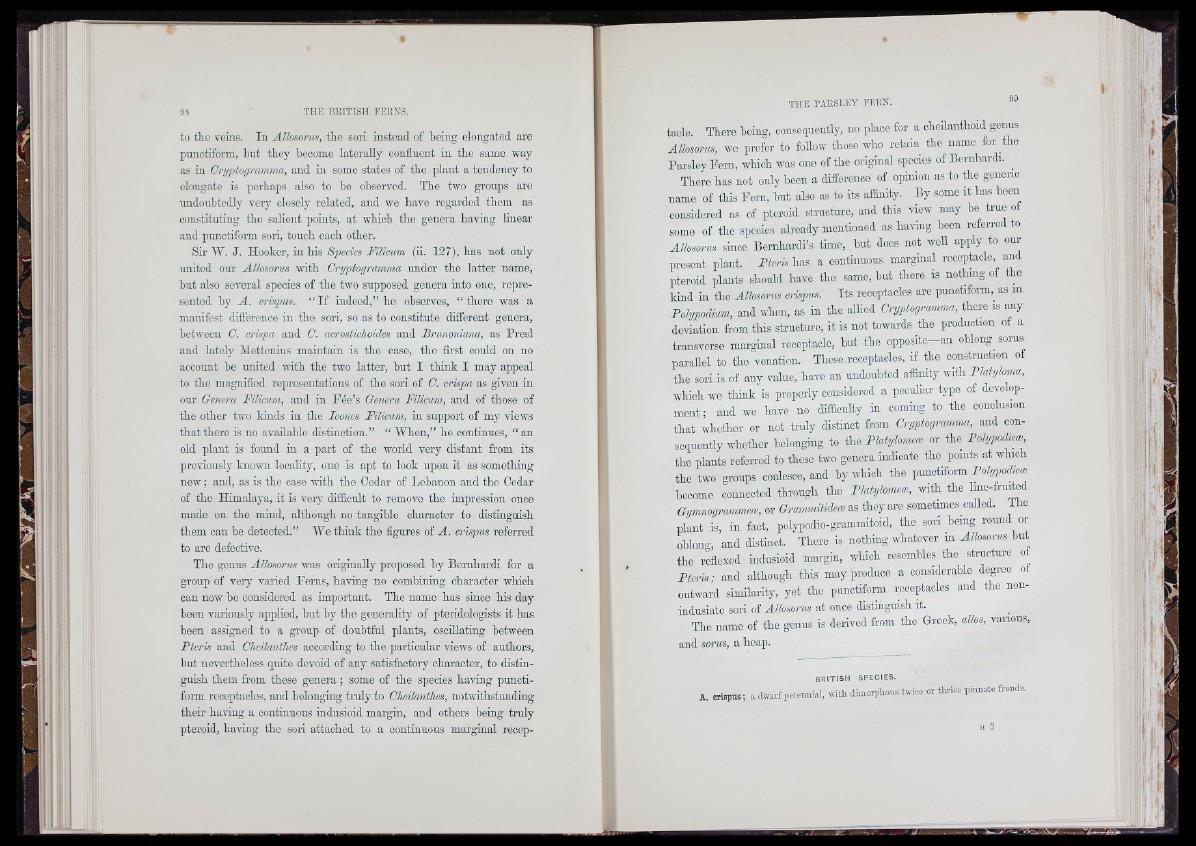
to tho veins. In AUosorus, the sori instead of being elongated arc
punotiform, but tboy become laterally confluent in tbo same way
as in Cnjpfogramma, and in some states of tbo plant a tendency to
elongate is porliaps also to bo observed. The two groups aro
uudoubtodly very closely related, and we have regarded tliom as
constituting tbe salient points, at wliicli tho genera having linear
and punotiform sori, touch each other.
Sir IV. J. Hooker, in his Species Filicum (ii. 127), has not only
united our Allosorus Avith Cryptogramma under tho latter name,
but also several spooios of tho two supposed genera into one, represented
hy A . crispus. “ I f indeed,” ho observes, “ there was a
manifest diffcrcnoo in the sori, so as to constitute different genera,
botAvoon C. crispa and C. aorostichoides and Brtinoniana, as Presl
and lately Mettenius maintain is the case, the first could on no
account bo united with tho two latter, but I think I may appeal
to tho magnified representations of the sori of C. crispa as given in
our Genera Filieum, and in Fee’s Genera Filicum, and of thoso of
the other two kinds in tho loones Filicum, in support of my views
that there is no available distinction.” “ When,” he continues, “ an
old plant is found in a part of the world very distant from its
preAuously known locality, ono is apt to look upon it as something
now; and, as is the case Avith the Cedar of Lebanon and tho Cedar
of tho Himalaya, it is very difficult to remove the impression once
made on the mind, although no tangible character to distinguish
them can be detected.” We think the figures of A . crispus referred
to are dofectiA'C.
The genus Allosorus was originally proposed by Bornhardi for a
group of very varied Ferns, having no combining character which
can now ho considered as important. The name has since his day
been variously applied, hut hy tho generality of pteridologists it has
been assigned to a group of doubtful plants, oscillating betAveen
Pteris and Cheilanthes according to tbe particular views of authors,
but nevertheless quite devoid of any satisfactory oharaoter, to distinguish
them from thoso genera; some of tho species having punotiform
receptacles, and belonging truly to Cheilanthes, notAvithstanding
their having a continuous indusioid margin, and others being truly
pteroid, having the sori attached to a continuous marginal recoptaclo.
There hoing, consequently, no place for a chcilanthoid genus
AUosorus, wo prefer to follow thoso who retain tho name for the
Parsley Fern, which was ono of tho original species of Bornhardi. ^
There has not only boon a difference of opinion as to tiio gonono
name of this Fern, hut also as to its affinity. By some it has boon
considered as of pteroid structure, and this view may he true oi
some of the species already mentioned as having been referred to
Allosorus since Bernliardi’s time, but does not well apply to our
present plant. Pteris has a continuous marginal receptacle, and
pteroid plants should havo the same, hut there is nothing of the
kind in the AUosorus crispus. Its receptacles are punotiform, as in
Pohjpodium, and when, as in the aUiod Cryptogramma, there is any
deviation from this structure, it is not towards ^the production of a
transverse marginal receptacle, but the opposite an ohloUf, sorus
parallel to tho venation. These.reooptaoles, if the oonstrnotion of
the sori is of any value, have an nndonhtcd affinity with Platyloma,
Avhioh wo think is properly considered a peculiar type of development
; and we have no difficulty in coming to tho conclusion
th a t whether or not truly distinct from Cryptogramma, and consequently
Avhethcr belonging to the Platylomeae or the Pohjimhew
the plants referred to thoso two genera indicate tho points at Avliich
the two groups coalesce, and hy which the punctiform Pofyporfic®
become connected through the Platylomecc, with the line-fruited
Gymnogrammew, or Grammitidew as they aro sometimes^called. Ih e
plant is, in fact, poUqiodio-grammitoid, the son being round or
oblong, and distinct. There is nothing Avhatevor in Allosorus but
tlie rcfloxed indusioid margin, which resembles the structure oi
Pteris; and although this may prodnco a considorablo degree oi
outward similarity, yet the punotiform receptacles and the non-
indnsiate sori of AUosorus at once distinguish it.
The name of the genus is derived from the Greek, alios, various,
and sorus, a heap.
BRITISH SPECIES.
A. crispus ; a dAvarf pereuuial, Avitli dimorplious twice or thrice pinnate fronds.
J,
I I
I ii